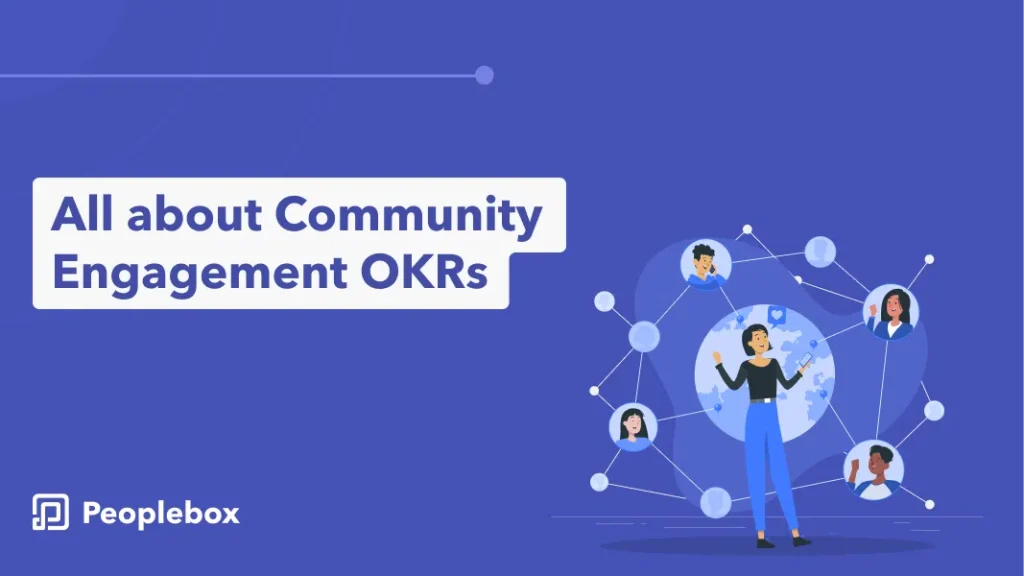Communities are the lifeblood of any organization. They provide support, feedback and a sense of belonging that fuels growth. It is the communities that foster innovation and build trust.
- They help build an organization’s reputation and brand image
- Creates brand loyalty by fostering a feeling of belonging and the same values
- Helps in understanding the needs of the customer for tailoring products and provides feedback for innovation
- Reduces marketing costs by encouraging word of mouth and community loyalty

But community engagement doesn’t happen overnight or just by chance. It takes a deliberate effort and a strategic approach to build a community and keep them engaged.
Community engagement OKRs do that for you. They act as a dynamic framework that helps amplify community impact and transforms how you connect with your communities.
In this article, we will talk about how community engagement OKRs help build a strong relationship with your community. How you can align community engagement OKRs with your overall business objectives and drive meaningful outcomes.
Best Practices for Crafting Effective Community Engagement OKR
Well-defined objectives that deeply resonate with the community’s interests and values.
OKRs are meant to bring clarity so when you set community engagement OKRs you set clear and meaningful objectives. Start by setting the objectives of community engagement OKRs that align with the broader organizational goals. They must always resonate with the interests and values of the community. They should address the needs and aspirations of the community ensuring genuine efforts are made to create relevant and impactful OKRs. The community engagement OKRs should be specific, concise, achievable and shouldn’t be ambiguous.
This also helps in planning resources for designing thoughtful community programs and achieving tangible outcomes without the need for additional resources.
Construct quantifiable Key Results to measure progress and maintain focus
The key results play an important role in tracking progress and ensuring accountability. When you set community engagement OKRs, ensure they are quantifiable and actionable. This will help you measure the success of the community engagement efforts. For example, your objective is to increase community participation. Your OKR can be specific metrics like a percentage increase in the number of participants and participation. The KR can include measuring the percentage increase in the active community members, level of engagement on social media, etc. Having precise KRs keeps your focus on achieving the desired outcomes and provides a clear path when it comes to evaluating success.
Strike a balance between being challenging and achievable
Striking the right balance between moonshot and achievable community engagement goals is very crucial. Easy objectives may fail to drive meaningful progress and over-ambitious goals can cause frustration and burnout in your team. You must engage with community stakeholders to understand their expectations and then set OKRs that offer some challenges but do not overwhelm the community and your team members. Here, it is important to regularly review OKRs and make adjustments to ensure objectives stay motivating and attainable at all times.
You can check this Cheat Sheet to write OKRs!
Examples of Community Engagement OKRs
Example 1: Technology Company
Objective: Generate 200% Increase in Community Engagement to Fuel Innovation and Product Development
Key Results:
- Launch a bi-monthly “Ideation Challenge” campaign, gathering at least 100 unique ideas per challenge.
- Facilitate monthly feedback sessions with customers, resulting in a 20% increase in customer-reported suggestions implemented.
- Co-create two new features with the active involvement of the community within the next development cycle.
Example 2: E-commerce Company
Objective: Achieve a 150% Increase in Customer Advocacy and Engagement through Reviews and Referrals
Key Results:
- Increase the number of customer reviews on the website from 100 to 150 within the next quarter.
- Achieve a 20% rise in customer referral sign-ups, reaching 500 sign-ups by the end of the quarter.
- Respond to customer inquiries on social media within 30 minutes, maintaining a response rate of 95% for the next three months.
Example 3: SaaS Startup
Objective: Achieve 25% Growth in User Adoption and Gather User Feedback for Product Enhancement
Key Results:
- Increase the number of active users from 1,000 to 1,250 through targeted onboarding and feature tutorials in the next six months.
- Collect feedback from at least 500 users through surveys and feedback forms by the end of the current quarter.
- Implement 80% of the suggested feature improvements shared by the user community within the next two development cycles.
Example 4: Professional Services Firm
Objective: Achieve a 10% Increase in Client Engagement and Satisfaction for Long-term Partnerships
Key Results:
- Host monthly webinars on industry trends
- Achieve a customer satisfaction score (CSAT) of 90% or higher through post-project surveys for all completed projects this year.
- Implement personalized quarterly check-ins with top 20 clients to proactively address concerns and identify opportunities for improvement.
Example 5: Retail Chain
Objective: Strengthen Community Ties by Fostering a Thriving and Collaborative Local Community Around Stores
Key Results:
- Forge connections with a minimum of six new neighboring businesses, expanding the local network to 26 partners within the next two quarters.
- Hold monthly interactive in-store workshops on topics relevant to the community, fostering knowledge exchange and participation with an average of 50 attendees per session for the next year.
- Launch a community-driven loyalty program, targeting 1,000 sign-ups and achieving a 20% increase in customer participation within the first six months.
Tips for Implementing Community Engagement OKRs
1. Setting up and Managing Community Engagement OKRs
- Begin by understanding the needs and values of the community. Create objectives that resonate with the community and are impactful.
- The objectives should be specific, concise and free from jargon.
- The KRs should be quantifiable and aligned with the objectives. They should have clear metrics for tracking progress.
- Focus on OKR that will have a substantial impact on your community. You will get a grasp of it when you interact with them. Concentrate your efforts on initiatives that bring long-term well-being to the community.
- OKRs bring transparency. Ensure that your community engagement OKRs are well communicated to all stakeholders. This helps build trust and ensures everyone is on board with the strategy.

2. Involve Community Members
- Organize workshops, surveys, and focus groups to gather ideas and inputs. This fosters a sense of belonging in the community and reflects that you care for your community’s needs.
- Establish ongoing feedback mechanisms for the community. Encourage the community to share feedback, suggestions or concerns. You can interview community members or visit parts of the community to learn more about them.
- Recognise the efforts of the community members for actively participating in the community forums. Offer them incentives and rewards to further motivate them
3. Regular Check-Ins, Data Analysis, and Adaptations
- Schedule regular check-ins like quarterly and monthly 1:1s and team meetings to access the progress of the OKRs. This will help you evaluate what is working and what needs adjustments.
- Use data-driven insights and metrics to measure OKR success. Use tools such as Peoplebox to set OKRs, track them, analyze and gain insights into the patterns of the community.
- Adapt OKRs based on the feedback received from the community. Make pivot plans for initiatives that are not yielding the desired results.
- Foster a culture of continuous improvement and learning. Review previous OKRs, share the lessons learned from their implementation and use them to make informed decisions for future strategies.
Conclusion
Community engagement OKRs are imperative to ensuring that you build a stronger and a vibrant community that helps foster your growth.
Peoplebox is a versatile tool that can help you streamline the process of setting OKRs and executing strategies. It helps you define clear objectives, align them with the overarching goals, set quantifiable key results, track progress, offer feedback and review regularly hassle-free.
Peoplebox simplifies the process and also offers you analytics features for reading into the context of complex data, finding patterns and ensuring that OKRs remain on course and yield the desired results. It also offers you features for conducting 360-degree reviews right from your Slack and other performance management functions to create a holistic goal-setting and performance process.
Take a demo today to understand how precisely it can streamline your goals and performance!








